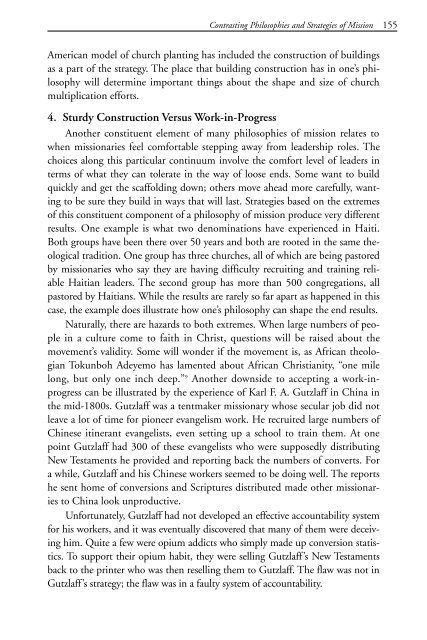discovering missions - Southern Nazarene University
discovering missions - Southern Nazarene University
discovering missions - Southern Nazarene University
Create successful ePaper yourself
Turn your PDF publications into a flip-book with our unique Google optimized e-Paper software.
245187 Disc Missions ins 9/6/07 1:04 PM Page 155<br />
Contrasting Philosophies and Strategies of Mission 155<br />
American model of church planting has included the construction of buildings<br />
as a part of the strategy. The place that building construction has in one’s philosophy<br />
will determine important things about the shape and size of church<br />
multiplication efforts.<br />
4. Sturdy Construction Versus Work-in-Progress<br />
Another constituent element of many philosophies of mission relates to<br />
when missionaries feel comfortable stepping away from leadership roles. The<br />
choices along this particular continuum involve the comfort level of leaders in<br />
terms of what they can tolerate in the way of loose ends. Some want to build<br />
quickly and get the scaffolding down; others move ahead more carefully, wanting<br />
to be sure they build in ways that will last. Strategies based on the extremes<br />
of this constituent component of a philosophy of mission produce very different<br />
results. One example is what two denominations have experienced in Haiti.<br />
Both groups have been there over 50 years and both are rooted in the same theological<br />
tradition. One group has three churches, all of which are being pastored<br />
by missionaries who say they are having difficulty recruiting and training reliable<br />
Haitian leaders. The second group has more than 500 congregations, all<br />
pastored by Haitians. While the results are rarely so far apart as happened in this<br />
case, the example does illustrate how one’s philosophy can shape the end results.<br />
Naturally, there are hazards to both extremes. When large numbers of people<br />
in a culture come to faith in Christ, questions will be raised about the<br />
movement’s validity. Some will wonder if the movement is, as African theologian<br />
Tokunboh Adeyemo has lamented about African Christianity, “one mile<br />
long, but only one inch deep.” 9 Another downside to accepting a work-inprogress<br />
can be illustrated by the experience of Karl F. A. Gutzlaff in China in<br />
the mid-1800s. Gutzlaff was a tentmaker missionary whose secular job did not<br />
leave a lot of time for pioneer evangelism work. He recruited large numbers of<br />
Chinese itinerant evangelists, even setting up a school to train them. At one<br />
point Gutzlaff had 300 of these evangelists who were supposedly distributing<br />
New Testaments he provided and reporting back the numbers of converts. For<br />
a while, Gutzlaff and his Chinese workers seemed to be doing well. The reports<br />
he sent home of conversions and Scriptures distributed made other missionaries<br />
to China look unproductive.<br />
Unfortunately, Gutzlaff had not developed an effective accountability system<br />
for his workers, and it was eventually discovered that many of them were deceiving<br />
him. Quite a few were opium addicts who simply made up conversion statistics.<br />
To support their opium habit, they were selling Gutzlaff’s New Testaments<br />
back to the printer who was then reselling them to Gutzlaff. The flaw was not in<br />
Gutzlaff’s strategy; the flaw was in a faulty system of accountability.

















